When it comes to running a successful food truck, there’s more to consider than just the menu.
If you’re a food truck owner or aspiring to become one, you’ve likely pondered the question: what size generator for a food truck?
In this guide, we’ll delve into the intricacies of selecting the right generator size to ensure your food truck can power all your culinary creations on the move.
What Size Generator For Food Truck?
For a standard food truck, a generator with a power output of 7,000 to 8,500 watts is generally sufficient. This range should adequately power cooking appliances, refrigeration, and other electrical needs, meeting most food truck energy requirements.
To give you an idea of what different generator sizes can power a food truck, here is a simplified table chart:
| Generator Size (Watts) | Appliances and Equipment |
|---|---|
| 2000 | Lights, fan, small fridge, coffee maker |
| 3000 | Lights, fan, small fridge, coffee maker, microwave |
| 4000 | Lights, fan, small fridge, coffee maker, microwave, blender |
| 5000 | Lights, fan, small fridge, coffee maker, microwave, blender, toaster oven |
| 6000 | Lights, fan, small fridge, coffee maker, microwave, blender, toaster oven, griddle |
| 7000 | Lights, fan, small fridge, coffee maker, microwave, blender, toaster oven, griddle, deep fryer |
| 8000 | Lights, fan, small fridge, coffee maker, microwave, blender, toaster oven, griddle, deep fryer, air conditioner |
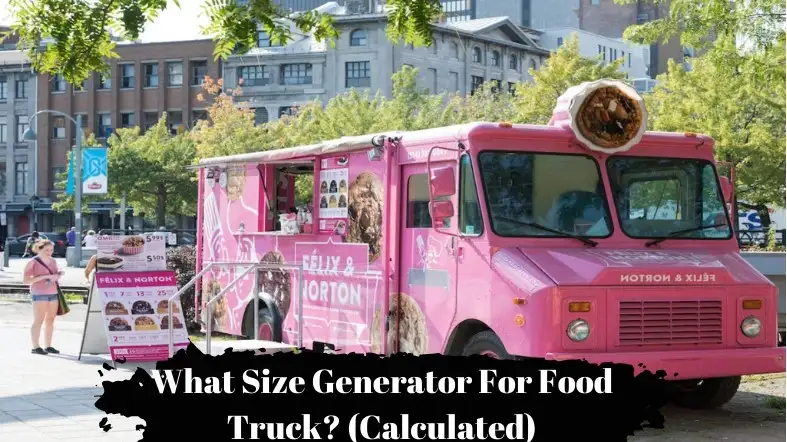
How to Calculate the Right Generator Size for Your Food Truck?
To calculate the right generator size for your food truck, you need to follow these steps:
Understanding Wattage Requirements
The first step is to understand the wattage requirements of your appliances and equipment.
You can find this information on the labels or manuals of your appliances and equipment.
You can also use online calculators or charts to estimate the wattage of common appliances and equipment.
Summing Up the Total Wattage
The next step is to sum up the total wattage of your appliances and equipment. This will give you the minimum power capacity that your generator needs to have.
For example, if you have a small fridge (600 Watts), a coffee maker (800 Watts), a microwave (1000 Watts), and a blender (400 Watts), your total wattage is 2800 Watts.
Factor in the Peak Loads
The total wattage is not enough to determine the right generator size. You also need to factor in the peak loads.
Peak loads are the extra power that some appliances and equipment need when they start up or run at full speed.
For example, a microwave might need 1000 Watts when running, but 1500 Watts when starting up.
To account for the peak loads, you need to add the highest peak load of your appliances and equipment to the total wattage.
For example, if your microwave has the highest peak load of 500 Watts, you need to add it to your total wattage of 2800 Watts. Your adjusted total wattage is 3300 Watts.
Safety Margins
You need to add some safety margins to your adjusted total wattage. Safety margins are extra power that you need to have in case of unexpected situations or fluctuations.
For example, you might need more power if you run more appliances and equipment at the same time, or if the weather is very hot or cold.
A good rule of thumb is to add 20% to 25% of your adjusted total wattage as safety margins.
For example, if your adjusted total wattage is 3300 Watts, you need to multiply it by 1.2 or 1.25. Your final total wattage is 3960 Watts or 4125 Watts.
>> What size generator for a popup camper?

>> What generator size for a microwave?
What Types Of Generators Do Food Trucks Use?
Here are some of the generator types for food trucks:
Gasoline Generators

These types of generators generate power from gasoline and propane tanks to provide electricity.
These generators work well when you need a light load that doesn’t require constant use.
Such as powering office equipment or small appliances on an outdoor event site.
They also can run up to 20 hours before refueling, which is perfect if your truck’s operating schedule isn’t too demanding.
Gasoline generators are portable and more affordable than diesel generators but they produce less power.
>> What size generator do I need for 13500 btu ac?
Diesel Generators

Create electrical current using a traditional engine with fuel injected into it for combustion in order to spin its internal rotors.
This generates mechanical energy that turns the alternator. Diesel generators need storage tanks for fuel.
Which can be gasoline or diesel. The power they produce is more consistent than that of a gas generator and will last longer before requiring refueling.
The initial investment costs are much higher, from $5000 to $20,000 USD.
Natural Gas Generators
Make electricity with an internal combustion engine powered by natural gas being combusted in order to spin its internal rotors.
This generates mechanical energy that turns the alternator. Natural gas generators tend to run quieter and cleaner than other types.
But their output fluctuates depending on how much natural gas you put into them.
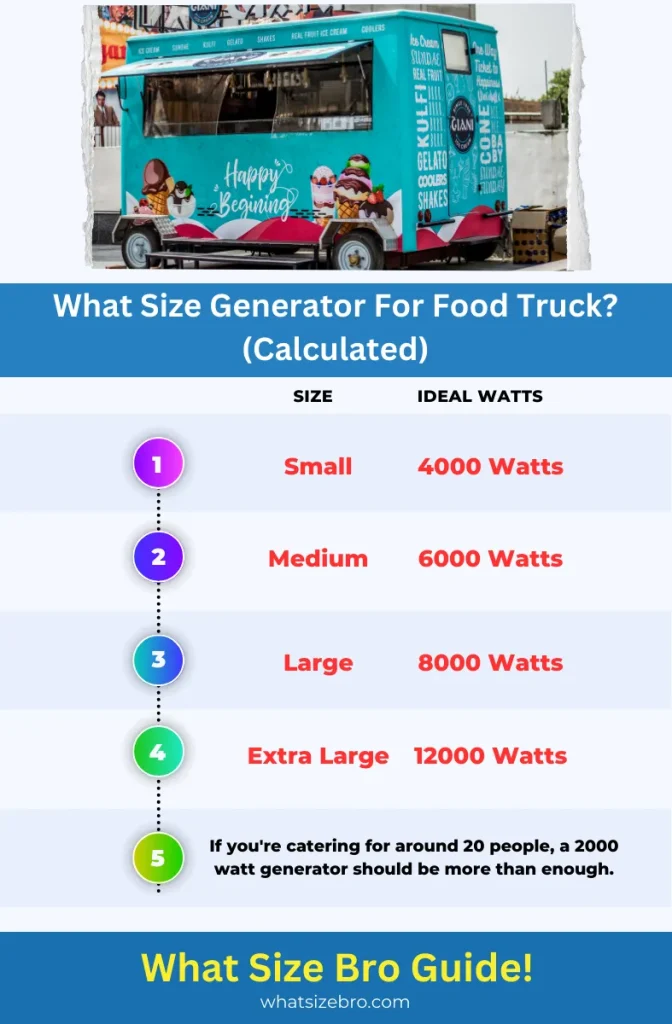
>> Which size generator for a space heater?
Solar Generators
These generators are typically powered by the sun. So they can produce power 24 hours a day.
They’re good for those who need to keep energy costs down and don’t want to depend on external sources of fuel.
As with natural gas generators, their output fluctuates depending on how much sunlight is present.
>> What size generator do I need to run central air conditioner?
Wind Generators
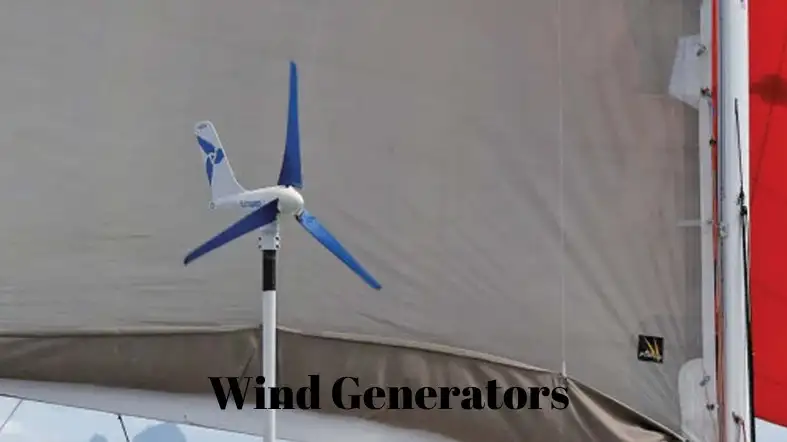
Generate electricity using wind turbines that use blades rotating in an area exposed to strong winds.
Wind generators require reliably powerful winds but once installed they do not require any other kind of maintenance apart from periodic inspections.
>> What size generator for 4 ton air conditioner?
What Features Should You Consider For Food Trucks Generator?

Fuel Source:
One of the most important factors to consider when choosing your generator is how it will be fueled.
Gasoline can run out in a power outage or if extreme weather conditions prevent refueling vehicles.
Gas stations may not reopen for days or weeks after a storm event (or other emergency), so diesel generators can go without fuel.
Diesel generators produce more electricity than gasoline models so that may allow them to keep operations going longer.
They require routine maintenance such as checking fuel filters, oil levels, and the air filter.
Diesel generators produce more noise than gasoline models so they may not be appropriate in some situations such as residential neighborhoods or near an airport.
>> What generator size for 140 amp welder?
Size:

The next consideration is how much power you need to run your operation each day typically measured in kilowatts (kW).
There are a variety of applications that will require different sizes of generators with ranges from about 500 watts for basic operations up to 1000 kW for large restaurants generating hundreds of pounds per hour.
For example, if you serve 300 people per day between 11 am and 12 pm then you would need a 10000-12000 watt generator based on a 50% load.
Gasoline vs. Electric:
There are also two types of fuel you might consider: gasoline or an electric model.
A gas generator may be the most cost-effective and most powerful option if your food truck runs for only four hours a day.
If the operation needs to run all day long every day then it would be best to rely on electricity since there’s no need to refuel them with costly gas at all times.
Just plug them into any outlet like a computer or TV, and flip the switch!
This type of generator could cost between $1000-$2000 depending upon how much power it creates (in kilowatts) and how much it can hold on reserves.
>> What size generator for a 3 bedroom home?
Food Truck Size:
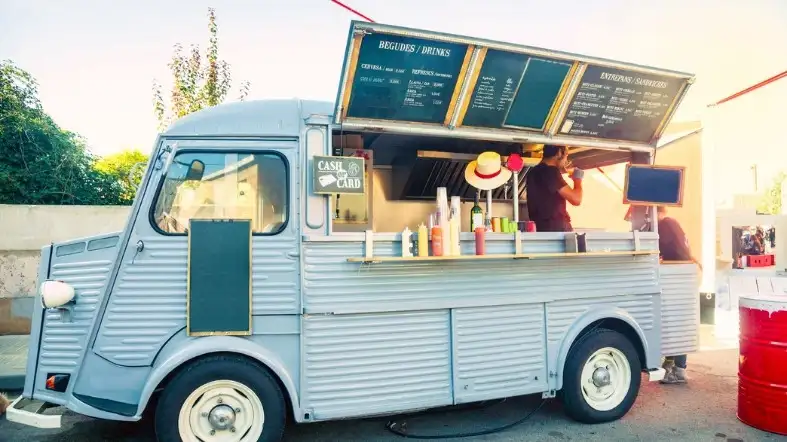
The size of your food truck will also have an impact on the type and size of a generator you need to purchase or rent.
A small trailer that is less than six feet in height may require no more than 500 watts. While those with five times as much space inside might use a 2000 watt model at full load.
These figures are based on 50% power consumption from gas-powered generators. If they’re used for the entire day then 5000-watt models would be necessary.
All this doesn’t even take into account what types of cooking equipment are being utilized such as grills, ovens, or fryers which all use kilowatts during operation.
>> What size generator to operate refrigerator and freezer?
How Loud Is It:
The sound of the generator will be dependent on its size and fuel type. Some models are nearly silent while others can produce up to 80 decibels at full speed.
Many people purchase generators that are around 60 dB or less in terms of noise so they do not have to worry about disturbing their neighbors during operation.
Which may lead them to call the police department for assistance if there is a complaint filed against them.
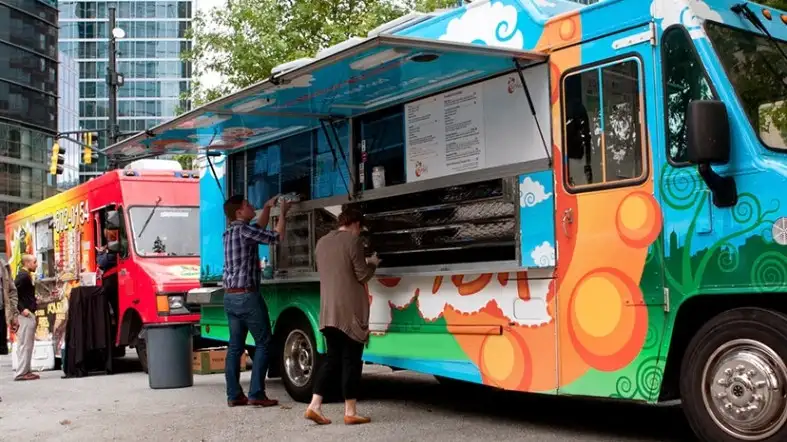
How do I set up the generator to power my food truck?

To set up the generator to power your food truck, you need to follow these steps:
Step 1
Choose the right generator size and type for your food truck, based on the factors explained above.
Step 2
Find a suitable location for your generator, preferably outside your food truck or in a well-ventilated compartment.
Make sure the generator is stable and secure, and away from any flammable materials or sources of heat.
Step 3
Connect the generator to your food truck’s electrical system using appropriate cables and connectors.
You may need an electrician to help you with this step, depending on the complexity of your wiring and the local codes.
Do not connect the generator directly to your appliances or equipment without a transfer switch.
Step 4
Connect the generator to a fuel source, such as gasoline, diesel, or propane. Make sure the fuel tank is full and the fuel lines are leak-free.
Follow the manufacturer’s instructions on how to start and operate the generator.
Step 5
Turn on the generator and check if it is working properly. Monitor the voltage, frequency, and power output of the generator.
Adjust the settings if needed. Do not overload the generator or run it for longer than necessary.
Step 6
Turn off the generator when you are done using it. Disconnect it from the fuel source and the electrical system. Store it in a safe and dry place.
Perform regular maintenance and inspections on the generator to ensure its optimal performance.
FAQs on What Size Generator For Food Truck
Should I get a propane or gas generator for a food truck?
What is the quietest generator for a food truck?
How do I wire the generator to the food truck?
Can I just use a small portable generator?
Final Thoughts
Navigating the food truck world isn’t just about tasty recipes and prime parking spots; you also need a dependable generator tailored to your electrical demands.
With the right planning, you’ll never have to worry about power outages dimming your sales or your reputation.
So go ahead, tally up those wattage needs, consider your fuel options, and make an informed choice. Boost your food truck’s bottom line and your business.
